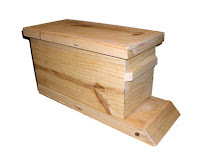
This is a photo of some of the wild plum that grows around the rivers in our area. The Bees love them.

This is a swam catch hive that I am trying out. It is a simple 5 gallon paint bucket with a hole drilled near the bottom. Inside the bucket is some fresh honey comb with queen pheromone inside the hive as well. Last year the bees actually began swarming at the end of March. I'll be ready. I think this may work because I have seen swarms collect in some empty 5 gallon buckets at my Dad's farm. They were simply laying around the side of the field and some had poision remaining in the buckets, and the  bees actually stayed for years.
bees actually stayed for years.
 bees actually stayed for years.
bees actually stayed for years.This is another swarm catch hive that I placed on my timber tract.
This is the 3rd of 3 swarm catch hives that I have on my timber tract. You can see the pheremone envelope on the front of this hive.

This is the 3rd of 3 swarm catch hives that I have on my timber tract. You can see the pheremone envelope on the front of this hive.
Maybe they will yield a hive or two.






4 comments:
Hey Paul,
I have 3 quick questions:
1 - About the wooden swarm catch, have you netted any swarms in that trap before?
2 - How far above the ground is it?
3 - Are those plum trees Chickasaw plums?
I like your blog. It reminds me of my years spent in AL.
Thanks
I have caught a swarm in the wooden catch hive last year.
They are about 6 feet above the ground. That is not ideal. I do this out of conveinece. The ideal height is 18 feet above ground. I just do not want a swarm that badly.
Chicasaw plums? I am not sure. My Dad just calls them a wild plum. I'll look it up and answer this one later in another blog. Thanks for your comments and for joining my blog.
Hemlock, I have talked to some people about what type of plum tree this is and they all agreed that this is a Chickasaw plum. Your right.
The 5 gallon bucket swarm trap is an ingenious idea. I think I'll try it this spring. Very nice blog. You're very creative.
Post a Comment